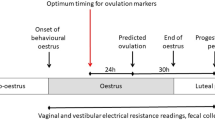Abstract
The use of Lewis rats in embryonic tissue transplantation experiments can present a challenge because of the fertility problems associated with this strain. The authors used estrous cycle phase determination to time pairings of reproductively active females and males in order to increase the likelihood that mating would occur. During a 24-month period, female rats in a production colony were evaluated for estrous phase by microscopic evaluation of vaginal smears and by vaginal impedance readings. Pairings that were arranged with females determined to be in the proestrous phase by vaginal smears resulted in a low rate of confirmed matings (14%). Serial vaginal smear sampling also produced a high incidence of pseudopregnancy. Pairings that were arranged with females determined to be in the proestrous phase by vaginal impedance readings resulted in a high rate of confirmed matings (48.1%) as well as a high rate of pregnancy (29.4%). An average of 7.2 embryos were produced per pregnancy. The vaginal impedance technique can be used to improve the breeding success rate of Lewis rats in order to maintain a stable production of embryos for experimentation.
This is a preview of subscription content, access via your institution
Access options
Subscribe to this journal
We are sorry, but there is no personal subscription option available for your country.
Buy this article
- Purchase on Springer Link
- Instant access to full article PDF
Prices may be subject to local taxes which are calculated during checkout



Similar content being viewed by others
References
Günther, E. & Walter, L. The major histocompatibility complex of the rat (Rattus norvegicus). Immunogenetics 53, 520–542 (2001).
Krinke, G.J. The Laboratory Rat (Academic, London, 2000).
Türk, G. et al. Effects of pomegranate juice consumption on sperm quality, spermatogenic cell density, antioxidant activity and testosterone level in male rats. Clin. Nutr. 27, 289–296 (2008).
Stephens, M.L. Personal reflections on Russell and Burch, FRAME, and the HSUS. Altern. Lab. Anim. 37, 29–33 (2009).
Iñigo, J.M. et al. Bienestar Animal Experimentación, Producción, Compañía y Zoológicos (Copisterías Don Folio S.L., Córdoba, España, 2003).
Cameron, N.M. Maternal programming of reproductive function and behavior in the female rat. Front. Evol. Neurosci. 3, 10 (2011).
Smith, C.C. et al. The estrous cycle and pituitary-ovarian function in Lewis and Fischer rats. Neuroimmunomodulation 1, 231–235 (1994).
Singletary, S.J. et al. Lack of correlation of vaginal impedance measurements with hormone levels in the rat. Contemp. Top. Lab. Anim. Sci. 44, 37–42 (2005).
Yener, T., Turkkani Tunc, A., Aslan, H., Aytan, H. & Cantug Caliskan, A. Determination of oestrous cycle of the rats by direct examination: how reliable? Anat. Histol. Embryol. 36, 75–77 (2007).
Ramos, S.D., Lee, J.M. & Peuler, J.D. An inexpensive meter to measure differences in electrical resistance in the rat vagina during the ovarian cycle. J. Appl. Physiol. 91, 667–670 (2001).
Bartos, L. Vaginal impedance measurement used for mating in the rat. Lab. Anim. 11, 53–55 (1977).
Taradach, C. Monitoring of the oestrous cycle in the rat by measurement of vaginal impedance. Arch. Toxicol. Suppl. 5, 184–186 (1982).
Council for International Organizations of Medical Sciences. International Guiding Principles for Biomedical Research Involving Animals (World Health Organization, Geneva, Switzerland, 1985).
Fernandez, C.D. et al. Diet-induced obesity in rats leads to a decrease in sperm motility. Reprod. Biol. Endocrinol. 9, 32 (2011).
LeFevre, J. & McClintock, M.K. Reproductive senescence in female rats: a longitudinal study of individual differences in estrous cycles and behavior. Biol. Reprod. 38, 780–789 (1988).
McClintock, M.K. Estrous synchrony and its mediation by airborne chemical communication (Rattus norvegicus). Horm. Behav. 10, 264–275 (1978).
McClintock, M.K. & Adler, N.T. Induction of persistent estrus by airborne chemical communication among female rats. Horm. Behav. 11, 414–418 (1978).
De Schaepdrijver, L.M., Fransen, J.L., Van der Eycken, E.S. & Coussement, W.C. Transverse vaginal septum in the specific-pathogen-free Wistar rat. Lab. Anim. Sci. 45, 181–183 (1995).
Lezmi, S. et al. Spontaneous metritis related to the presence of vaginal septum in pregnant Sprague Dawley Crl:CD(SD) rats: impact on reproductive toxicity studies. Vet. Pathol. 48, 964–969 (2011).
Orhijuela, P.A., Ortiz, M.E. & Croxatto, H.B. Sperm migration into and through the oviduct following artificial insemination at different phases of the estrous cycle in the rat. Biol. Reprod. 60, 908–913 (1999).
Acknowledgements
We thank Dr. Maria Helena Ortíz and Dr. Gabriela Méndez at the Universidad Católica at Santiago de Chile for their guidance with respect to the reproductive characteristics of the strain; Mrs. Olga Lucía Beltran for her management of the colony; and Dr. Ann Gregory for her review of the manuscript. This study is part of a research project funded by Colciencias and Universidad Javeriana Academic Vice-rectory.
Author information
Authors and Affiliations
Corresponding author
Ethics declarations
Competing interests
The authors declare no competing financial interests.
Rights and permissions
About this article
Cite this article
Jaramillo, L., Balcazar, I. & Duran, C. Using vaginal wall impedance to determine estrous cycle phase in Lewis rats. Lab Anim 41, 122–128 (2012). https://doi.org/10.1038/laban0512-122
Received:
Accepted:
Issue Date:
DOI: https://doi.org/10.1038/laban0512-122
This article is cited by
-
Staging of the estrous cycle and induction of estrus in experimental rodents: an update
Fertility Research and Practice (2020)
-
Anastrozole is a dose-specific superovulator and favors implantation in rats: a prospective study
Cell and Tissue Research (2016)



